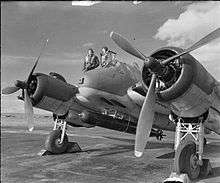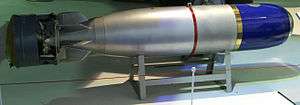British 18-inch torpedo
There have been a number of 18-inch torpedoes in service with the United Kingdom.
These have been used on ships of the Royal Navy and aircraft of both the Fleet Air Arm and Royal Air Force, while Royal Navy surface ships and submarines use 21-inch torpedoes.
The British "18-inch" torpedoes were 17.72 inches (45.0 cm) in diameter, beginning with the "Fiume" Whitehead torpedo of 1890.
45 cm "Fiume" (Whitehead) torpedo
First introduced into British service in 1894.
- Year : about 1888
- Weight : 845 lb (383 kg)
- Length : 11 ft 8 in (3.56 m)
- Warhead : 118 lb (54 kg) wet gun-cotton
- Performance : 26.5 knots (49.1 km/h; 30.5 mph) for 800 yd (730 m)
- Propulsion : Compressed air
Mark V
Used on the River-class and 1905 Tribal-class destroyers.
- Year : about 1899
- Weight : 1,353 lb (614 kg)
- Warhead : 296 lb (134 kg) including pistol
- Propulsion : Compressed air
Mark VI
Used on destroyers of the early 1900s.
- Year : about 1904
- Performance : 28.5 knots (52.8 km/h; 32.8 mph) for 4,000 yd (3,700 m) or 41 knots (76 km/h; 47 mph) for 1,000 yd (910 m)
- Propulsion : Compressed air
Mark VII and VII*
Introduced on the 1908 members of the 1905 Tribal class destroyers. Used by torpedo boats built before the First World War and destroyers. Used by RAF flying boats in the 1920s.
- Year : 1907
- Warhead : 320 lb (150 kg) TNT
- Performance :
- Mark VII :
30 knots (56 km/h; 35 mph) for 6,000–7,000 yd (5,500–6,400 m)
41 knots (76 km/h; 47 mph) for 3,000 yd (2,700 m) - Mark VII* :
29 knots (54 km/h; 33 mph) for 7,000 yd (6,400 m)
35 knots (65 km/h; 40 mph) for 5,000 yd (4,600 m)
- Mark VII :
- Propulsion : Wet-heater
Mark VIII
- Year: 1913
- Role: Submarines and aircraft (Note: During World War II and after the Mk.VIII was a 21-inch torpedo)
- Warhead: 320 lb (150 kg) TNT
- Propulsion: Wet heater
- Performance: 35 knots (65 km/h; 40 mph) for 2,500 yd (2,300 m)
Mark XI
- Year: 1934
- Aircraft carried
- Dimensions: 17.72 in (450 mm) dia.
- Warhead: 465 lb (211 kg) TNT
- Propulsion: Burner cycle
- Performance: 35 knots (65 km/h; 40 mph) for 2,500 yd (2,300 m)
Mark XII
| 18-inch Mark XII | |
|---|---|
 A Mark XII torpedo fitted to a Bristol Beaufighter | |
| Type | Torpedo |
| Place of origin | United Kingdom |
| Service history | |
| In service | 1937-1945 |
| Production history | |
| Designed | 1935 |
| Specifications | |
| Mass | 1,548 lb (702 kg) |
| Length | 16 ft 3 in (4.95 m) |
| Diameter | 17.72 in (450 mm) |
| Warhead | TNT |
| Warhead weight | 388 lb (176 kg) |
| Engine | Burner cycle 140 hp (at 40 knots) |
| Maximum speed | 40 knots (74 km/h; 46 mph) for 1,500 yd (1,400 m) or 37 knots (69 km/h; 43 mph) for 3,500 yd (3,200 m) |
Aircraft launched, used by Fleet Air Arm and RAF Coastal Command.
Mark XIV
| 18-inch Mark XIV | |
|---|---|
| Type | Torpedo |
| Place of origin | United Kingdom |
| Production history | |
| Designed | around 1938 |
| Specifications | |
| Mass | 1,630 lb (740 kg) |
| Diameter | 17.72 in (450 mm) |
| Warhead | TNT |
| Warhead weight | 375 lb (170 kg) |
| Engine | Whitehead wet heater (methyl fuel) |
| Maximum speed | 45 knots (83 km/h; 52 mph) for 1,650 yd (1,510 m) or 41 knots (76 km/h; 47 mph) for 2,950 yd (2,700 m) |
The Mark XIV was an aircraft-launched torpedo. Stocks were lost with the fall of Singapore.
Mark XV
- Year: 1942
- Operators: Fleet Air Arm, RAF Coastal Command, Royal Navy
- Role: Aircraft and Motor Torpedo Boats, 1943 onwards
- Dimensions: 17.72 in (450 mm) × 17 ft 3 in (5.26 m)
- Warhead: 545 lb (247 kg) Torpex
- Propulsion: Burner cycle
- Performance: 40 knots (74 km/h; 46 mph) for 2,500 yd (2,300 m) or 33 knots (61 km/h; 38 mph) for 3,500 yd (3,200 m)
Mark XVI
Electric torpedo project not completed.
Mark XVII
- United Kingdom, 1944
- Aircraft launched
- Operated by FAA, RAF Coastal Command, Blackburn Firebrand
- Dimensions: 17.72 in (450 mm) × 17 ft 3 in (5.26 m)
- Warhead: 600 lb (270 kg) Torpex
- Propulsion: Burner cycle
- Performance: 40 knots (74 km/h; 46 mph) for 2,500 yd (2,300 m)
Mark 30

An air-dropped passive acoustic homing torpedo known as "Dealer" and "Dealer B". "Dealer" did not see service use, but its successor, "Dealer B" (the Mark 30 Mod 0), was issued from June 1954. Considered very successful, with approximately 1,200 being built, it served in both the Royal Navy and RAF until 1970. The Mark 30 Mod 1 had several improvements, but this program was cancelled in 1955 in favour of purchasing Mark 43 Mod 3 torpedoes from the US.[2]
- Length: 8 ft (2.4 m)[3]
- Weight: 646 lb (293 kg)
- Performance: 12.5 knots (23.2 km/h; 14.4 mph) for 3,000 yd (2,700 m) or 19 knots (35 km/h; 22 mph) for 830 yd (760 m)
See also
- List of torpedoes
- British 21-inch torpedo
Notes
- "British Torpedoes after World War II". navweaps.com. Retrieved 7 July 2010.
- "Mk 30 Torpedo". saairforce.co.za. Retrieved 7 July 2010.
References
- Tony DiGiulian, Pre Second World War torpedoes
- Tony DiGiulian, Torpedoes of the Second World War